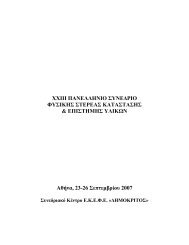Synthesis, spectroscopic, structural and electrochemical studies of ...
Synthesis, spectroscopic, structural and electrochemical studies of ...
Synthesis, spectroscopic, structural and electrochemical studies of ...
Create successful ePaper yourself
Turn your PDF publications into a flip-book with our unique Google optimized e-Paper software.
A.K. Boudalis et al. / Inorganica Chimica Acta 361 (2008) 1681–1688 1687originates from the presence <strong>of</strong> an electron-donating 3-substituentin compounds 5 <strong>and</strong> 6.5. ConclusionsThe aim <strong>of</strong> this study was to further extend our investigationson iron-quinone complexes [6], <strong>and</strong> more specificallyto prepare new lig<strong>and</strong>s allowing us to locate analkylated 1,4-naphthoquinone moiety in the second coordinationsphere <strong>of</strong> iron(II) through binding <strong>of</strong> a carboxylsubstituent [31] borne by its alkyl chain. To this purpose,we have prepared, <strong>spectroscopic</strong>ally (IR,1 H <strong>and</strong>13 C NMR) <strong>and</strong> <strong>structural</strong>ly characterized, <strong>and</strong> extensivelystudied the <strong>electrochemical</strong> properties <strong>of</strong> two quinonederivatives <strong>of</strong> organic acids, 3-3 0 -methyl-1 0 ,4 0 -dioxo-1 0 ,4 0 -dihydronaphthalen-2 0 -yl propanoic acid (3) <strong>and</strong> 4-3 0 -methyl-1 0 ,4 0 -dioxo-1 0 ,4 0 -dihydronaphthalen-2 0 -yl butanoicacid (4), derived from MNQ. An improved purificationmethod allowed us to obtain pure 3 <strong>and</strong> 4 in high yield,<strong>and</strong> subsequently to grow single crystals allowing to determinetheir molecular structure. The exhaustive <strong>electrochemical</strong>study <strong>of</strong> 3 <strong>and</strong> 4 led us to prepare <strong>and</strong> fullycharacterize their ethyl esters, 5 <strong>and</strong> 6, respectively. This<strong>electrochemical</strong> study has evidenced that the redox behaviour<strong>of</strong> the 3-carboxyl substituted derivatives 3 <strong>and</strong> 4 isvery different from that <strong>of</strong> MNQ, while their esters 5 <strong>and</strong>6 have the typical redox behaviour <strong>of</strong> 1,4-naphthoquinoneslike MNQ. The origin <strong>of</strong> this difference has been elucidated:the presence <strong>of</strong> a substituent able to act as a protonsource, <strong>and</strong> to promote hydrogen bonding, associated withchanges in the usual reduction waves <strong>of</strong> quinones has beenrationalized on the basis <strong>of</strong> an ECE (e H + e ) mechanisminvolving intramolecular self-protonation <strong>of</strong> the semiquinoneradical prior to the second electron transfer <strong>and</strong> stabilization<strong>of</strong> the electro-generated intermediate species,probably an hetero-conjugate acid–base dimer, by hydrogenbonding [22,25–30]. It is then expected that coordination<strong>of</strong> the (deprotonated) carboxo substituent <strong>of</strong> 3 <strong>and</strong> 4to a metal centre may yield an alkylated 1,4-naphthoquinonemoiety in the second coordination sphere <strong>of</strong> iron(II)showing the typical redox behaviour <strong>of</strong> 1,4-naphthoquinones:the preparation <strong>and</strong> study <strong>of</strong> such metal complexesis presently underway in our laboratories.AcknowledgementsA.K.B. thanks the European Community for partialsupport through a doctoral grant within the framework<strong>of</strong> the TMR contract FMRX-CT980174. We thank Dr.Yannick Coppel, Dr. Penelope Liatsi <strong>and</strong> Dr. MontserratRodriguez for helpful discussions.Appendix A. Supplementary materialCCDC 258106 <strong>and</strong> 258107 contain the supplementarycrystallographic data for 3 <strong>and</strong> 4. These data can beobtained free <strong>of</strong> charge via http://www.ccdc.cam.ac.uk/conts/retrieving.html, or from the Cambridge CrystallographicData Centre, 12 Union Road, Cambridge CB21EZ, UK; fax: (+44) 1223-336-033; or e-mail: deposit@ccdc.cam.ac.uk. Supplementary data associated with thisarticle can be found, in the online version, atdoi:10.1016/j.ica.2007.02.027.References[1] (a) R.H. Thomson, Naturally Occurring Quinones, Academic Press,New York, 1971;(b) R.A. Morton, Biochemistry <strong>of</strong> Quinones, Academic Press, NewYork, 1965.[2] P.J. O’Brien, Chem. Biol. Interact. 80 (1991) 1.[3] (a) P. Zuman, Substituent Effects in Organic Polarography, PlenumPress, New York, 1967;(b) S. Patai, The Chemistry <strong>of</strong> the Quinonoid Compounds, Wiley,London, 1974.[4] (a) T. Iyanagi, I. Yamazaki, Biochim. Biophys. Acta 216 (1970) 282;(b) M. Nakamura, I. Yamazaki, Biochim. Biophys. Acta 267 (1972)249.[5] R.M. Buchanan, C.G. Pierpont, Coord. Chem. Rev. 38 (1981) 45.[6] (a) P. Garge, S. Padhye, J.-P. Tuchagues, Inorg. Chim. Acta 157(1989) 239;(b) P. Garge, R. Chikate, S. Padhye, J.-M. Savariault, P. de Loth, J.-P. Tuchagues, Inorg. Chem. 29 (1990) 3315.[7] (a) J. Deisenh<strong>of</strong>er, O. Epp, K. Miki, R. Huber, H. Michel, J. Mol.Biol. 180 (1984) 385;(b) J. Deisenh<strong>of</strong>er, O. Epp, K. Miki, R. Huber, H. Michel, Nature318 (1985) 19;(c) H. Michel, O. Epp, J. Deisenh<strong>of</strong>er, EMBO J. 5 (1986) 2445;(d) J. Deisenh<strong>of</strong>er, H. Michel, Angew. Chem., Int. Ed. 28 (1989) 829;(e) J.P. Allen, G. Feher, T.O. Yeates, H. Komiya, D.C. Rees, Proc.Natl. Acad. Sci. USA 84 (1987) 5730;(f) J.P. Allen, G. Feher, T.O. Yeates, H. Komiya, D.C. Rees, Proc.Natl. Acad. Sci. USA 85 (1988) 8487.[8] (a) A. Zouni, H.-T. Witt, J. Kern, P. Fromme, N. Krauß, W.Saenger, P. Orth, Nature 409 (2001) 739;(b) K.N. Ferreira, T.M. Iverson, K. Maghlaoui, J. Barber, S. Iwata,Science 303 (2004) 1831.[9] (a) R.K. Clayton, Photosynthesis: Physical Mechanisms <strong>and</strong> ChemicalPatterns, Cambridge University Press, 1980;(b) B.A. Diner, G.T. Babcock, in: D.R. Ort, C.F. Yocum (Eds.),Oxygenic Photosynthesis: The Light Reactions, Kluwer AcademicPublishers, Dordrecht, 1996, pp. 213–247.[10] P. Cassoux, R. Dartiguepeyron, D. de Montauzon, J.B. Tommasino,P.L. Fabre, Actual. Chim. 1 (1994) 49.[11] L. Heslinga, W. Schwaiger, Recl. Trav. Chim. 85 (1966) 75.[12] L.F. Fieser, R.B. Turner, J. Am. Chem. Soc. 69 (1947) 2338.[13] SIR92 – A program for crystal structure solution A. Altomare, G.Cascarano, C. Giacovazzo, A. Guagliardi, J. Appl. Crystallogr. 26(1993) 343.[14] SIR97– A. Altomare, M.C. Burla, M. Camalli, G.L. Cascarano, C.Giacovazzo, A. Guagliardi, A.G.G. Moliterni, G. Polidori, R.Spagna, J. Appl. Crystallogr. 32 (1999) 115.[15] G.M. Sheldrick, SHELX97 [Includes SHELXS97, SHELXL97, CIFTAB] –Programs for Crystal Structure Analysis (Release 97-2), Institüt fürAnorganische Chemie der Universität Göttingen, Göttingen, Germany,1998.[16] WINGX – 1.63 integrated system <strong>of</strong> windows programs for the solution,refinement <strong>and</strong> analysis <strong>of</strong> single crystal X-ray diffraction data L.Farrugia, J. Appl. Crystallogr. 32 (1999) 837.[17] International Tables for X-Ray Crystallography, vol. IV 1974,Kynoch Press, Birmingham, Engl<strong>and</strong>.[18] ORTEP3 for Windows – L.J. Farrugia, J. Appl. Crystallogr. 30 (1997)565.
















